Now Reading: How Institutional Flows and Market Cycles Are Shifting
-
01
How Institutional Flows and Market Cycles Are Shifting
How Institutional Flows and Market Cycles Are Shifting

Bitcoin Magazine

How Institutional Flows and Market Cycles Are Shifting
Year-to-date, bitcoin returns are flat — at negative 0.4%. This is far from bitcoin’s returns in 2024 at +121% and its compound annual growth rate of 98.60% over the last 13 years.
After hitting an all-time high of $109,000 on January 20, 2025, Bitcoin price suffered a severe drop three months later: During the worldwide tariff fright on April 9, bitcoin dropped as low as $76,000. At the time of writing, it’s trading at around $106,000 — about 6% below its ATH milestone.
Given the intensity of turmoil that President Trump’s trade war caused, it appears that it is now exceedingly unlikely for bitcoin to ever reach the deep, discounted levels of its less mature self. At the same time, is it likely for bitcoin price to exceed the $112,000 all-time high, or will it again topple under sell-off pressure?
To attempt to answer that, let’s examine which factors are coming into play a year after Bitcoin’s halving.
Are Bitcoin Fundamentals Still Sound?
The fourth Bitcoin halving last April slashed miner block rewards from 6.25 BTC to 3.125 BTC. Consequently, it lowered Bitcoin’s inflation rate to 0.83%, which is significantly lower even than the Federal Reserve’s target inflation rate of 2%.
As always, Bitcoin’s fundamentals can be summed up in simple terms:
- Mass democracy requires escalating government spending and social programs to fortify people’s reliance and allegiance. Consequently, government spending ignites steep budget deficits, totaling almost $2 trillion in 2024.
- Massive budget deficits spur the central bank into action, devaluing the dollar. After all, if the quantity of dollars outpaces the quantity of real assets, those assets will be priced higher. Over time, people start looking for an exit route to safeguard wealth.
- The more voting there is, the worse the problem gets. This necessitates technological solutions outside electoral politics in which public opinion is engineered via centralized information distribution nodes.
- Bitcoin is uniquely positioned to take advantage of this need. Although Bitcoin is digital, making it fit for the modern age, its proof-of-work mechanism ties it to physical assets — machines and energy.
- Combined with the programmed scarcity of 21 million bitcoin, alongside the decentralization of Bitcoin’s computing network, this makes Bitcoin a relatively safe asymmetric bet against a debt-based monetary system.
In a hypothetical scenario, if the Federal Reserve permanently halts all money supply machinations, the U.S. government would have to rely on investors buying bonds to cover its deficits. But as we’ve seen during the reciprocal tariffs fiasco, the bond market responds to fundamentals.
For this reason, the Treasury’s operations would have to become sound. However, the stability of the dollar, as the world’s reserve currency, relies on both domestic spending for social programs and military hegemony spending.
In other words, it is difficult to picture a world in which it is possible for the government to become fiscally sound. Therefore, its reliance on the Federal Reserve to devalue the dollar has to be maintained as a matter of course.
Obstacles in the Way of Bitcoin Fundamentals
Now that we understand the nature of the beast, it is easy to see why bitcoin managed to attract so much capital over the years, with the notable drawdown exceptions in 2018 and 2022:
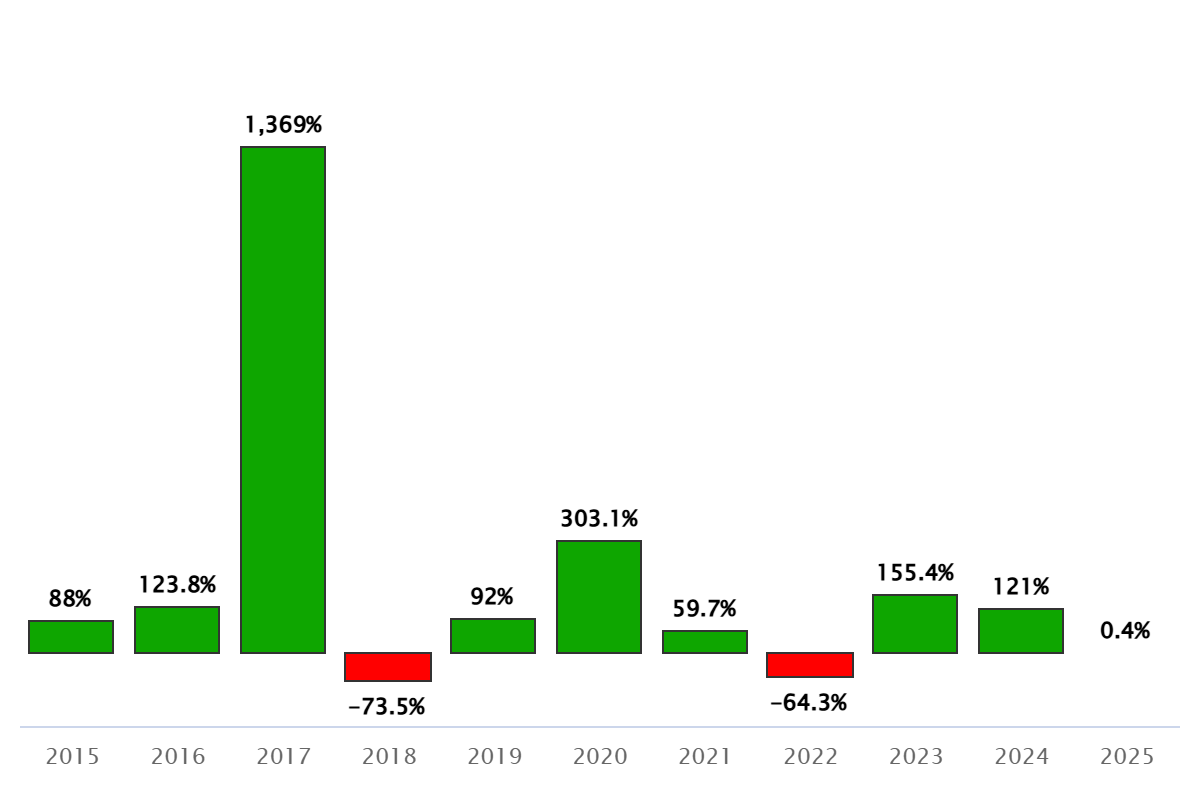
Simply put, the Bitcoin network exists to capture capital flows from a system that relies on monetary debasement. From this starting framework, it is then easy to see what would get in the way of capturing those inflows:
- Is it feasible to scale the education of the populace on Bitcoin’s fundamentals, i.e., central banking and monetary theory?
- How high is the cognitive ceiling that curtails the scaling of educational efforts?
- Is the institutional sanctification of Bitcoin sufficient to offset the cognitive ceiling?
- Are fiat-to-bitcoin rails sufficiently convenient to accept capital inflows?
Worldwide, fiat-to-BTC conversion is theoretically possible for 76% of the world’s population (~6 billion), as this is the number of people with bank accounts. However, this percentage drastically goes down when one accounts for nations that debanked cryptocurrencies, partially or fully. Whether it’s due to worries about cloud security of certain platforms, as well as the still-glaring lack of strong regulatory frameworks.
Furthermore, one has to account for the culture of saving and investing itself. It is clear that Americans have the most developed investing culture, with 62% of adults having exposure to the stock market. And as of 2023, the FDIC reported that 96% of U.S. households are banked.
Of course, the U.S. stock market mirrors U.S. hegemony and the U.S. dollar as reserve currency, meaning that its stock market routinely outperforms global equities. When accounting for all these factors, it is then not surprising to see that, out of ~6 billion banked people globally, up to 130.4 million individuals received exposure to bitcoin — a trifle (0.002%) of the banked population.
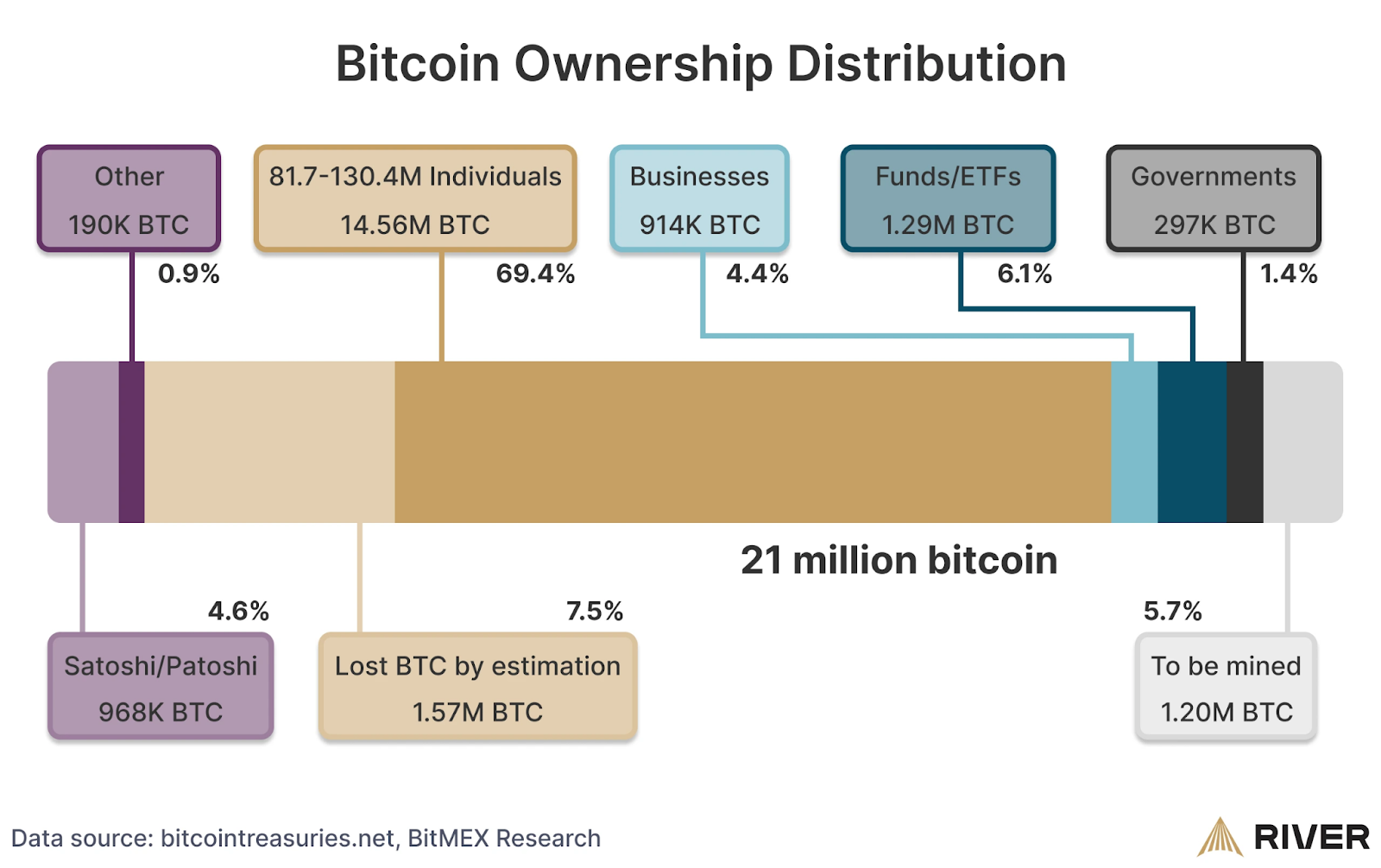
Nonetheless, 21 million is itself a tiny figure compared to 6 billion, rendering retail participation moot. And early 2024 and 2025 were exceptionally fortifying for Bitcoin fundamentals.
In January 2024, the Securities and Exchange Commission (SEC) approved a series of spot-traded ETFs. Not only did this place bitcoin alongside stocks for capital inflows, but bitcoin was institutionally sanctified.
This pivotal milestone made it more difficult for mainstream media to paint bitcoin as illegitimate. Likewise, the heads of large financial institutions initiated a sharp turnaround, as evidenced by Larry Fink, CEO of BlackRock.
On top of bitcoin’s institutionalization via ETFs in 2024, President Trump’s administration not only canceled Operation Choke Point 2.0, but moved to form a Strategic Bitcoin Reserve. Given that public opinion is an artifact of mainstream media, it is now less relevant what the public knows about Bitcoin but rather how Bitcoin is framed.
Altogether, Bitcoin is now more nestled within the system than ever before. This translates into less friction for fiat-to-BTC inflows. Historically, global M2 money supply correlates highly with Bitcoin price, now poised for another jump.
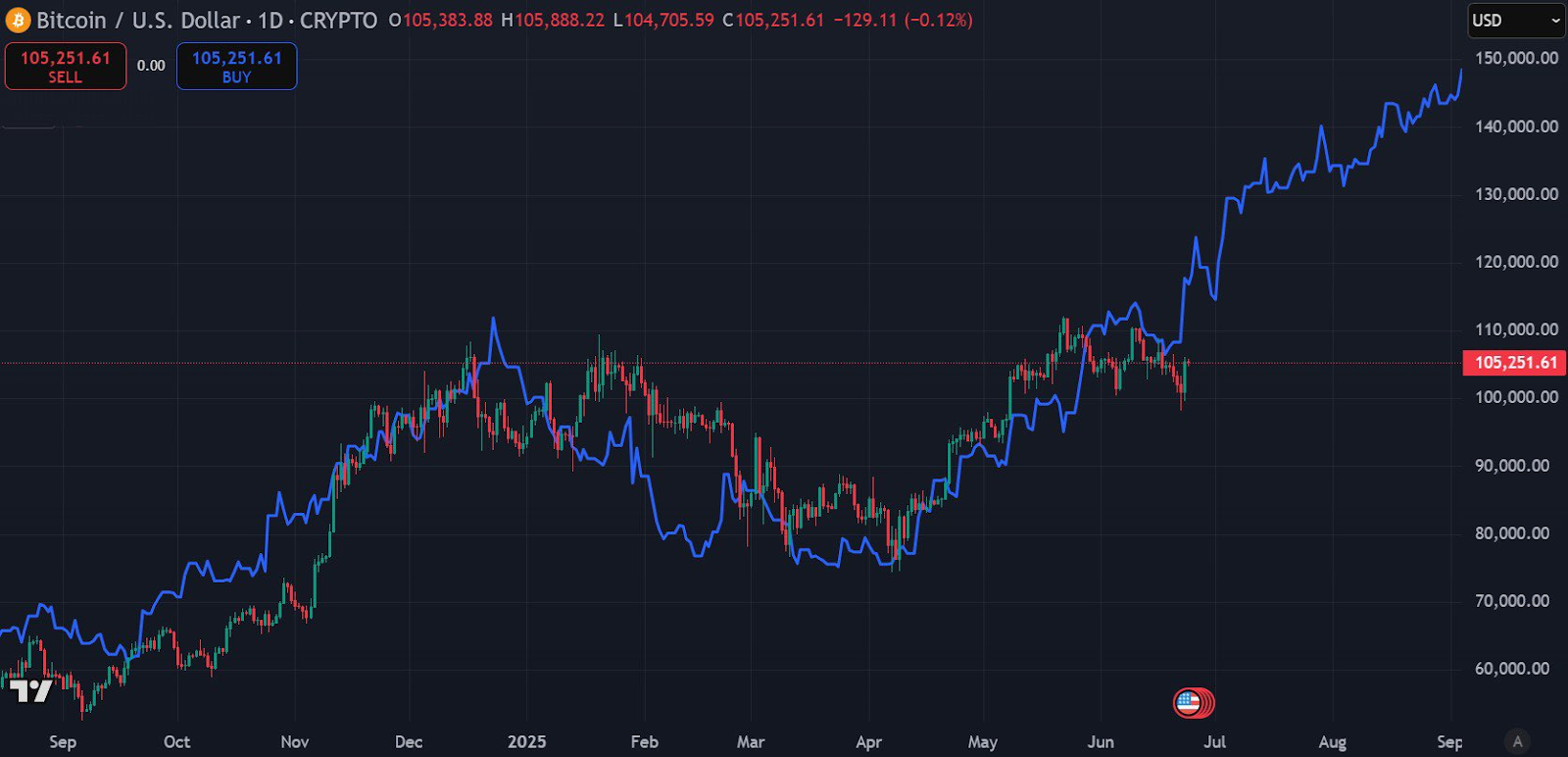
Ultimately, bitcoin lacks the complexity of quarterly earnings reports. In a culture accustomed to stock investing, this simplicity may attract greater inflows as investors seek refuge from dollar devaluation.
Post-Halving Performance Failure in 2024/2025
Following each halving, bitcoin’s gains tend to fall within a 12-month period. The third halving was an exception due to unprecedented global monetary stimulus combined with low interest rates.
- 1st halving in 2012: BTC price up 7,000% over 12 months.
- 2nd halving in 2016: BTC price up 291% over 12 months.
- 3rd halving in 2020: BTC price up 541% over 12 months.
- 4th halving in 2024: BTC price up 43% over 12 months.
During that post-2020 period of cheap money we also saw a crypto boom, tied to overleveraged crypto platforms such as BlockFi, FTX, Celsius, Voyager Digital and others. When the Federal Reserve reversed course in March 2022 and started rapidly rising interest rates, the central bank triggered a cascade of crypto bankruptcies.
In turn, the remaining retail turned to degen gambling known as memecoin trading — a trend that only widened the gulf between bitcoin and altcoins, pushing bitcoin dominance to 64%, amplifying the importance of trading rooms, where focused bitcoin discussions have replaced the fragmented noise of altcoin hype.
Nonetheless, crypto debanking, crypto bankruptcies and fraudulent memecoins left a mark. According to Kaiko research figures, Bitcoin’s fourth halving period now tracks for the worst performance.
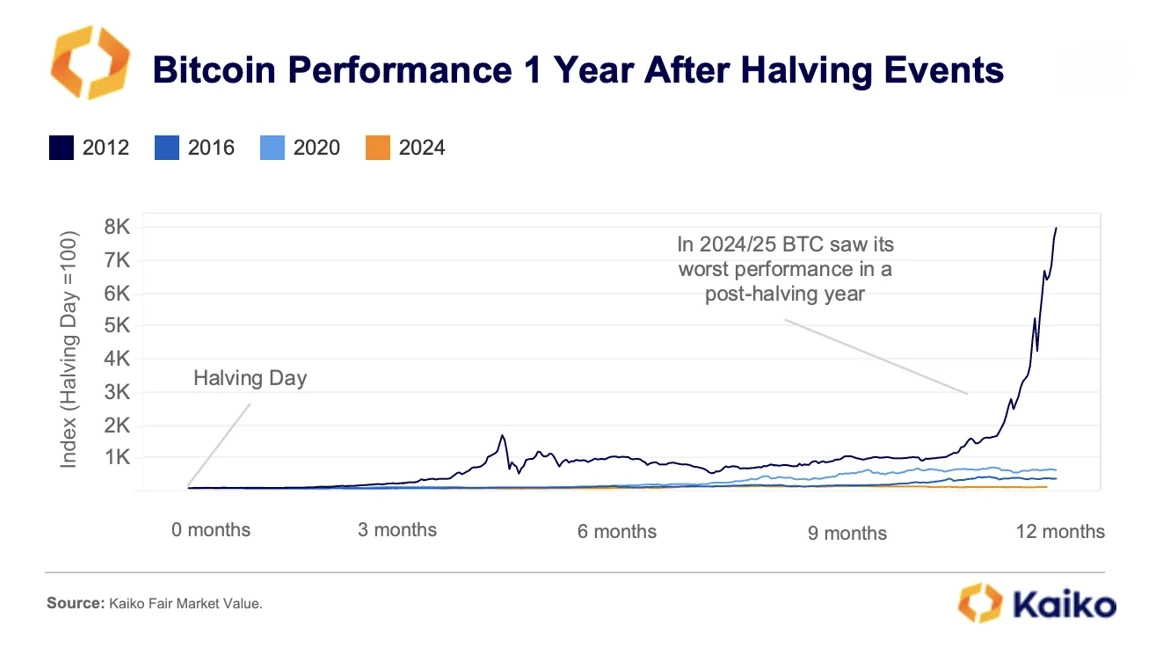
At the same time, Bitcoin miners are acting as if this is a temporary performance lapse. Reminder: With lower BTC block rewards and unchanged price, miners receive less value for the same computing power exerted and associated costs.
For this reason, miners count on the BTC price to go up to compensate for the loss. And if some miners succumb to economic pressure, they exit the network and reduce Bitcoin’s network total hashrate.
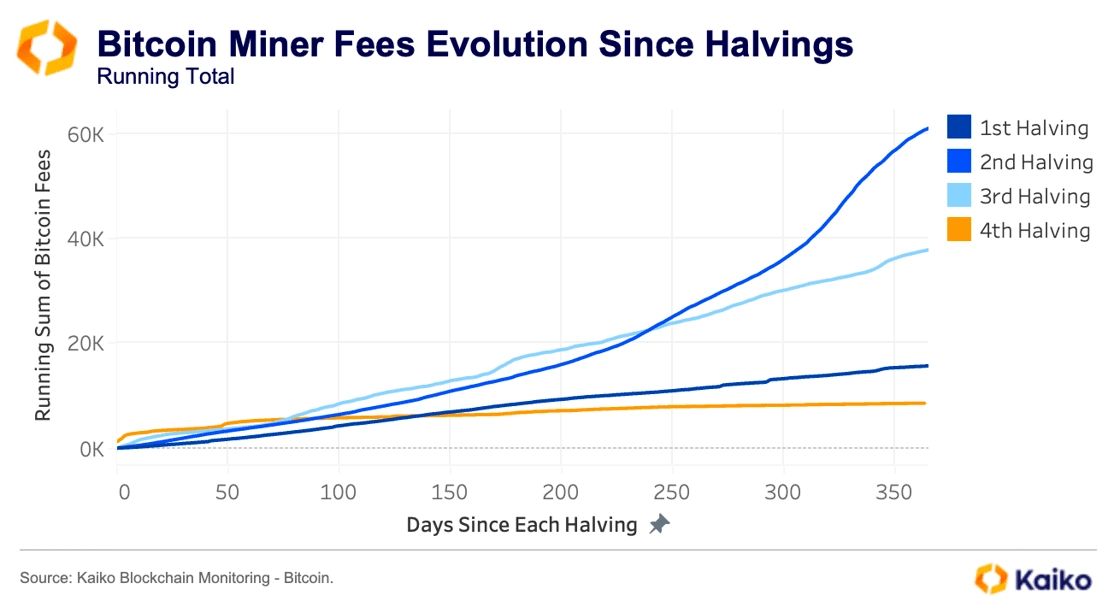
However, over a one-year period, Bitcoin’s hashrate has gone steadily up, having reached an all-time high in April. This suggests a couple of scenarios:
- If many miners get squeezed out from the lack of prolonged BTC price performance, this will exert a sell-off pressure. Is this likely to be accompanied by dip-buyers is anyone’s guess, but Bitcoin’s institutional maturity and lack of structural vulnerability suggest the dip will be bought up.
- Consequently, if Bitcoin’s mining difficulty is lowered from the exit of inefficient miners, remaining miners will gain greater profitability. This process has unfolded many times.
- If macro conditions, such as global money supply, push BTC price higher in the second half of 2025, there is no sell-off pressure; the BTC price rapidly skyrockets.
In either scenario, bitcoin’s unique fundamentals enter the calculus to keep the BTC price up over the long term. In a way, as retail participation slumps, this is more likely to prevent major sell-off pressures. After all, funds and publicly traded companies are focused on long-term trajectories and fundamentals, not on short-term expenditures for consumption needs.
In the end, bitcoin’s steadily rising hashrate and institutional maturity underscore its resilience. Any sell-off pressures are likely to be absorbed by long-term investors to sustain upward price momentum.
This post How Institutional Flows and Market Cycles Are Shifting first appeared on Bitcoin Magazine and is written by Shane Neagle.















:max_bytes(150000):strip_icc()/GettyImages-2160063874-dac1723bba53434d90f515221b18477c.jpg?ssl=1)











:max_bytes(150000):strip_icc()/ORCLChart-3225fba5219d45cfbd32da6362efba94.gif?w=150&resize=150,150&ssl=1)

